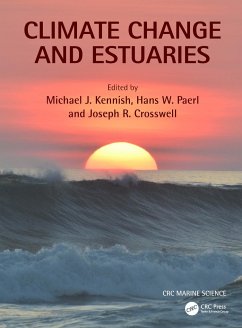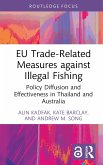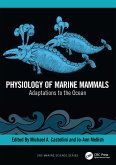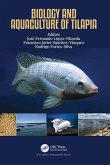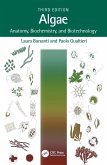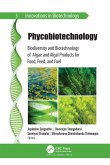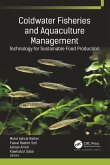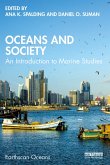Climate Change and Estuaries
Herausgeber: Paerl, Hans W.; Kennish, Michael J.; Crosswell, Joseph R.
Climate Change and Estuaries
Herausgeber: Paerl, Hans W.; Kennish, Michael J.; Crosswell, Joseph R.
- Gebundenes Buch
- Merkliste
- Auf die Merkliste
- Bewerten Bewerten
- Teilen
- Produkt teilen
- Produkterinnerung
- Produkterinnerung
Climate change is having an increasing impact on estuarine and marine environments worldwide. This handbook provides state-of-the-art coverage of climate change effects on estuarine ecosystems from local, regional, and global perspectives.
Andere Kunden interessierten sich auch für
![EU Trade-Related Measures against Illegal Fishing EU Trade-Related Measures against Illegal Fishing]() Alin KadfakEU Trade-Related Measures against Illegal Fishing46,99 €
Alin KadfakEU Trade-Related Measures against Illegal Fishing46,99 €![Physiology of Marine Mammals Physiology of Marine Mammals]() Physiology of Marine Mammals73,99 €
Physiology of Marine Mammals73,99 €![Biology and Aquaculture of Tilapia Biology and Aquaculture of Tilapia]() Biology and Aquaculture of Tilapia94,99 €
Biology and Aquaculture of Tilapia94,99 €![Algae Algae]() Laura BarsantiAlgae147,99 €
Laura BarsantiAlgae147,99 €![Phycobiotechnology Phycobiotechnology]() Phycobiotechnology111,99 €
Phycobiotechnology111,99 €![Coldwater Fisheries and Aquaculture Management Coldwater Fisheries and Aquaculture Management]() Coldwater Fisheries and Aquaculture Management203,99 €
Coldwater Fisheries and Aquaculture Management203,99 €![Oceans and Society Oceans and Society]() Oceans and Society31,99 €
Oceans and Society31,99 €-
-
-
Climate change is having an increasing impact on estuarine and marine environments worldwide. This handbook provides state-of-the-art coverage of climate change effects on estuarine ecosystems from local, regional, and global perspectives.
Hinweis: Dieser Artikel kann nur an eine deutsche Lieferadresse ausgeliefert werden.
Hinweis: Dieser Artikel kann nur an eine deutsche Lieferadresse ausgeliefert werden.
Produktdetails
- Produktdetails
- CRC Marine Science
- Verlag: Taylor & Francis Ltd
- Seitenzahl: 664
- Erscheinungstermin: 15. September 2023
- Englisch
- Abmessung: 281mm x 212mm x 39mm
- Gewicht: 2010g
- ISBN-13: 9780367647520
- ISBN-10: 0367647524
- Artikelnr.: 68099499
- Herstellerkennzeichnung
- Produktsicherheitsverantwortliche/r
- Europaallee 1
- 36244 Bad Hersfeld
- gpsr@libri.de
- CRC Marine Science
- Verlag: Taylor & Francis Ltd
- Seitenzahl: 664
- Erscheinungstermin: 15. September 2023
- Englisch
- Abmessung: 281mm x 212mm x 39mm
- Gewicht: 2010g
- ISBN-13: 9780367647520
- ISBN-10: 0367647524
- Artikelnr.: 68099499
- Herstellerkennzeichnung
- Produktsicherheitsverantwortliche/r
- Europaallee 1
- 36244 Bad Hersfeld
- gpsr@libri.de
Dr. Michael J. Kennish is a professor emeritus in the Department of Marine and Coastal Sciences, School of Environmental and Biological Sciences, Rutgers University, New Brunswick, New Jersey. His career in coastal, estuarine, and marine sciences spans nearly 50 years and has included extensive multidisciplinary research on coastal, estuarine, and marine ecosystems. He has also taught coastal and marine science classes at Rutgers University for many years. In addition, he has been active for decades in the outreach of science to coastal communities and K-12 schools. As a member of the Climate Institute at Rutgers University, Dr. Kennish has been involved in the study of long-term climate change impacts on the New Jersey coast and elsewhere. He was an expert reviewer of the Sixth Assessment Report of the Intergovernmental Panel on Climate Change (IPCC) published in 2021 (WGI) and 2022 (WGII and WGIII). Dr. Kennish is the author or editor of 16 scholarly books on various topics in coastal, estuarine, and marine sciences, the author or editor of more than 200 research articles in science journals and other publications, and the editor of 9 peer-reviewed compendium science journal special issues. Dr. Kennish has maintained a wide range of research interests in marine ecology and marine geology. He has been most actively involved in leading research teams investigating estuarine and coastal marine environments in New Jersey. Much of this research has involved in the development and application of innovative methods to determine the condition and ecosystem health of coastal ecosystems in the state. Dr. Kennish is widely known for his work on the human impacts of coastal, estuarine, and marine environments and has served on environmental panels and workgroups assessing these problems in New Jersey, the mid-Atlantic region, and nationwide, while concomitantly collaborating extensively with state and federal government agencies to remediate degraded water quality and habitats. Most notably, he has been heavily engaged in investigations of impairment and remediation of impacted estuarine and coastal marine environments. These include studies of the natural and anthropogenic stressors that effect change in coastal ecosystems as well as the dynamics of environmental forcing factors that generate imbalances in biotic community structure and ecosystem function. His research, which has been funded by the USEPA, NOAA, USDA, state environmental agencies, and other federal and state sources, is multidisciplinary in scope. It addresses an array of nationally significant problems, such as habitat loss and alteration of aquatic systems, nutrient enrichment and eutrophication, hypoxia and anoxia, organic pollution, chemical contaminants, climate change, sea level rise, overfishing, invasive species, watercraft effects, dredging and dredged-material disposal, freshwater diversions, calefaction of estuarine waters, entrainment and impingement of electric generating stations, and the effects of watershed development on coastal systems. In addition, he has examined the effects of construction and operation of industrial facilities, maintenance of shorelines and waterways, and human use of coastal space and aquatic systems. He has also studied the biology and geology of mid-ocean ridge and deep-sea hydrothermal vent systems as a member of the Center for Deep-Sea Ecology and Biotechnology at Rutgers University. Dr. Kennish is the recipient of many awards, including the 2008 Guardian of the Barnegat Bay Award (Barnegat Bay National Estuary Program/USEPA), 2009 NOAA/NERRA National Award for outstanding contributions to the National Estuarine Research Reserve System of NOAA, 2010 Graham Macmillan Award of the American Littoral Society for significant contributions to marine science and conservation, 2010 Sierra Club Award for outstanding environmental accomplishments, 2011 Pearl S. Schwartz Environmental Award of the League of Women Voters for work on New Jersey's coastal environments, 2013 Frank Oliver Award of the New Jersey Environmental Lobby for contributions to the protection of New Jersey's environments, and the 2017 Albert Nelson Marquis Lifetime Achievement Award for dedication to the environmental and oceanographic sciences. Dr. Hans W. Paerl is the Kenan Professor of Marine and Environmental Sciences at the University of North Carolina's Institute of Marine Sciences. He holds a joint appointment with the Departments of Earth, Marine and Environmental Sciences and Environmental Sciences and Engineering. His collaborative research addresses microbially-mediated nutrient cycling and primary production dynamics, environmental controls and management of harmful algal (specifically cyanobacterial) blooms. Dr. Paerl's research spans freshwater lakes, reservoirs (including ones used as drinking water supplies), estuarine and coastal marine waters in the US and globally (see: https://paerllab.web.unc.edu/research/). He has published over 350 peer reviewed articles and book chapters on these subjects. His work has been supported by the NSF, EPA, NIH, NOAA/NC Sea Grant, USDA, The NC Water Resources Research Institute, the UNC Collaboratory, the California Bay Delta Science Program, various State environmental agencies and private foundations, the Chinese Academy of Sciences and Ministry of Science and Technology and the Netherlands Academy of Sciences. He also manages several estuarine water quality monitoring and assessment programs, including the Neuse River Estuary (NC) Modeling and Monitoring Program, ModMon (https://paerllab.web.unc.edu/projects/modmon/) and the Ferry-based Water Quality Monitoring Program for the Pamlico Sound System, FerryMon (https://paerllab.web.unc.edu/projects/ferrymon/). Dr. Paerl has supervised over 70 graduate students, 12 post-docs, and advises undergraduate students at UNC-CH as well as other institutions. He received the 2003 G. Evelyn Hutchinson Award from the Association of the Sciences of Limnology and Oceanography (ASLO), and the 2011 Odum Award from the Coastal and Estuarine Research Federation (CERF) for addressing the causes, consequences and controls of eutrophication and harmful algal blooms in aquatic ecosystems. In 2015, he was named a Fellow of the American Geophysical Union (AGU), and in 2022 he received the Lifetime Achievement Award from the US Harmful Algal Bloom Committee. He is a fellow of the Royal Dutch Academy of Sciences and a holds honorary joint faculty positions at the Hohai University and the Nanjing Institute of Geography and Limnology, Chinese Academy of Sciences, both located in Nanjing, China. Dr. Joseph (Joey) Crosswell is a senior research scientist at the Commonwealth Scientific and Industrial Research Organization (CSIRO). Dr. Crosswell's core research examines connectivity of coastal systems, particularly carbon and nutrient cycling between sediment, ocean, and atmosphere (see https://people.csiro.au/c/j/joey-crosswell). He is particularly interested in exploring diverse and remote coastal systems, ranging from mangroves to mesoscale eddies and from arid tropical estuaries in northern Australia to fjords in southern Chile. Dr. Crosswell has served as Chief Scientist on 22 research voyages at CSIRO, leading cruises to more than 70 estuaries and coral reefs in the Great Barrier Reef ecosystem as well as voyages to other remote regions of Australia, Patagonia, Fiji, Papua New Guinea, and Indonesia. He has supervised seven graduate students, two postdocs and several undergraduate students at institutions spanning six countries. A key element of Dr. Crosswell's research involves developing new tools and methods for coastal observations. These include instrument platforms for measuring carbonate chemistry and physical processes in estuaries, which have been deployed over the past 15 years in waters along the mid-Atlantic coast of the USA, the east Australian coast, and in Chilean fjords. More recently, Dr. Crosswell has collaborated with CSIRO researcher-engineers on the application of computer vision to detect crown of thorns starfish outbreaks in the Great Barrier Reef as well as machine learning models for mapping seagrass across the Indo-Pacific. Dr. Crosswell plays an active role in advancing national and international research strategy and collaboration. Since 2020, he has been co-leader of the research domain Coastal Mapping and Monitoring within CSIRO's Environment Business Unit. He has served as a nominated author for expert scientific assessments in the USA and Australia, such as the 2nd State of the Carbon Cycle Report. He is a founding member of an international working group focused on feedbacks between carbon cycling and extreme events, e.g., tropical cyclones, floods, and wildfires. He leads research and field studies for multi-lateral initiatives exploring blue carbon as a resource for climate action and sustainable livelihoods across the Indo-Pacific. Dr. Crosswell has received an Innovators Fellowship from the Deshpande Foundation, a Collaborative Research Award from the Burroughs Wellcome Fund, a Research Impact Award from the University of North Carolina, and the 2022 CSIRO Collaboration medal.
Foreword. Preface. The Editors. Contributors. Section 1: Physical-Chemical
Aspects. Chapter 1 Introduction to Climate Change and Estuaries. Chapter 2
Climate Change in the Earth System. Chapter 3 Estuaries: Origin, Historical
Development, and Classifications. Chapter 4 Sea-level Rise and Estuaries.
Chapter 5 Anthropogenic Drivers of Estuarine Change. Chapter 6 Climate
Change and Saltwater Intrusion in Estuaries. Chapter 7 Biogeochemical
Changes in Estuaries. Chapter 8 Hypoxia and Climate Change in Estuaries.
Chapter 9 Estuarine Acidification Under a Changing Climate. Chapter 10
Global Change and Estuarine Carbon Dynamics. Chapter 11 Blue Carbon in a
Changing Climate and a Changing Context. Chapter 12 Effects of a Changing
Climate on the Physics of Estuaries. Chapter 13 Climatic Drivers of
Estuarine Sediment Dynamics. Chapter 14 Climate Change Effects on
Intertidal and Subtidal Environments: Impacts, Projections, and Management.
Section 2: Biological Aspects. Chapter 15 Estuarine and Coastal Marine
Organism Responses to Climate Change: An Introduction. Chapter 16 Microbial
Ecology in a Changing Climate. Chapter 17 Climate Change, Phytoplankton,
and HABs. Chapter 18 Responses of Marine Macroalgae to Climate Change
Drivers. Chapter 19 Climate Change Effects on Salt Marshes. Chapter 20
Mangrove Forests and Climate Change: Impacts and Interactions. Chapter 21
Estuarine Seagrass and Climate Change. Chapter 22 Estuarine Benthos and
Climate Change. Chapter 23 Estuarine Shellfish and Climate Change. Chapter
24 Climate Change Effects on Fish Populations. Chapter 25 Estuarine and
Coastal Birds, Climate Change, and Sea Level Rise. Chapter 26 Climate
Change and Invasive Species. Chapter 27 Animal Response to Hypoxia in
Estuaries and Effects of Climate Change. Section 3: Management Aspects.
Chapter 28 Perspectives on Managing Estuaries while Addressing the Climate
Crisis. Chapter 29 Sea-level Rise Risk and Adaptation in Estuaries. Chapter
30 Managing for Resilience of Estuarine and Coastal Marine Environments to
Climate Change. Chapter 31 Climate Change Adaptation of Engineering
Infrastructure in Estuarine Environments. Chapter 32 Conserving and
Managing Estuaries during Climate Change. Index.
Aspects. Chapter 1 Introduction to Climate Change and Estuaries. Chapter 2
Climate Change in the Earth System. Chapter 3 Estuaries: Origin, Historical
Development, and Classifications. Chapter 4 Sea-level Rise and Estuaries.
Chapter 5 Anthropogenic Drivers of Estuarine Change. Chapter 6 Climate
Change and Saltwater Intrusion in Estuaries. Chapter 7 Biogeochemical
Changes in Estuaries. Chapter 8 Hypoxia and Climate Change in Estuaries.
Chapter 9 Estuarine Acidification Under a Changing Climate. Chapter 10
Global Change and Estuarine Carbon Dynamics. Chapter 11 Blue Carbon in a
Changing Climate and a Changing Context. Chapter 12 Effects of a Changing
Climate on the Physics of Estuaries. Chapter 13 Climatic Drivers of
Estuarine Sediment Dynamics. Chapter 14 Climate Change Effects on
Intertidal and Subtidal Environments: Impacts, Projections, and Management.
Section 2: Biological Aspects. Chapter 15 Estuarine and Coastal Marine
Organism Responses to Climate Change: An Introduction. Chapter 16 Microbial
Ecology in a Changing Climate. Chapter 17 Climate Change, Phytoplankton,
and HABs. Chapter 18 Responses of Marine Macroalgae to Climate Change
Drivers. Chapter 19 Climate Change Effects on Salt Marshes. Chapter 20
Mangrove Forests and Climate Change: Impacts and Interactions. Chapter 21
Estuarine Seagrass and Climate Change. Chapter 22 Estuarine Benthos and
Climate Change. Chapter 23 Estuarine Shellfish and Climate Change. Chapter
24 Climate Change Effects on Fish Populations. Chapter 25 Estuarine and
Coastal Birds, Climate Change, and Sea Level Rise. Chapter 26 Climate
Change and Invasive Species. Chapter 27 Animal Response to Hypoxia in
Estuaries and Effects of Climate Change. Section 3: Management Aspects.
Chapter 28 Perspectives on Managing Estuaries while Addressing the Climate
Crisis. Chapter 29 Sea-level Rise Risk and Adaptation in Estuaries. Chapter
30 Managing for Resilience of Estuarine and Coastal Marine Environments to
Climate Change. Chapter 31 Climate Change Adaptation of Engineering
Infrastructure in Estuarine Environments. Chapter 32 Conserving and
Managing Estuaries during Climate Change. Index.
Foreword. Preface. The Editors. Contributors. Section 1: Physical-Chemical
Aspects. Chapter 1 Introduction to Climate Change and Estuaries. Chapter 2
Climate Change in the Earth System. Chapter 3 Estuaries: Origin, Historical
Development, and Classifications. Chapter 4 Sea-level Rise and Estuaries.
Chapter 5 Anthropogenic Drivers of Estuarine Change. Chapter 6 Climate
Change and Saltwater Intrusion in Estuaries. Chapter 7 Biogeochemical
Changes in Estuaries. Chapter 8 Hypoxia and Climate Change in Estuaries.
Chapter 9 Estuarine Acidification Under a Changing Climate. Chapter 10
Global Change and Estuarine Carbon Dynamics. Chapter 11 Blue Carbon in a
Changing Climate and a Changing Context. Chapter 12 Effects of a Changing
Climate on the Physics of Estuaries. Chapter 13 Climatic Drivers of
Estuarine Sediment Dynamics. Chapter 14 Climate Change Effects on
Intertidal and Subtidal Environments: Impacts, Projections, and Management.
Section 2: Biological Aspects. Chapter 15 Estuarine and Coastal Marine
Organism Responses to Climate Change: An Introduction. Chapter 16 Microbial
Ecology in a Changing Climate. Chapter 17 Climate Change, Phytoplankton,
and HABs. Chapter 18 Responses of Marine Macroalgae to Climate Change
Drivers. Chapter 19 Climate Change Effects on Salt Marshes. Chapter 20
Mangrove Forests and Climate Change: Impacts and Interactions. Chapter 21
Estuarine Seagrass and Climate Change. Chapter 22 Estuarine Benthos and
Climate Change. Chapter 23 Estuarine Shellfish and Climate Change. Chapter
24 Climate Change Effects on Fish Populations. Chapter 25 Estuarine and
Coastal Birds, Climate Change, and Sea Level Rise. Chapter 26 Climate
Change and Invasive Species. Chapter 27 Animal Response to Hypoxia in
Estuaries and Effects of Climate Change. Section 3: Management Aspects.
Chapter 28 Perspectives on Managing Estuaries while Addressing the Climate
Crisis. Chapter 29 Sea-level Rise Risk and Adaptation in Estuaries. Chapter
30 Managing for Resilience of Estuarine and Coastal Marine Environments to
Climate Change. Chapter 31 Climate Change Adaptation of Engineering
Infrastructure in Estuarine Environments. Chapter 32 Conserving and
Managing Estuaries during Climate Change. Index.
Aspects. Chapter 1 Introduction to Climate Change and Estuaries. Chapter 2
Climate Change in the Earth System. Chapter 3 Estuaries: Origin, Historical
Development, and Classifications. Chapter 4 Sea-level Rise and Estuaries.
Chapter 5 Anthropogenic Drivers of Estuarine Change. Chapter 6 Climate
Change and Saltwater Intrusion in Estuaries. Chapter 7 Biogeochemical
Changes in Estuaries. Chapter 8 Hypoxia and Climate Change in Estuaries.
Chapter 9 Estuarine Acidification Under a Changing Climate. Chapter 10
Global Change and Estuarine Carbon Dynamics. Chapter 11 Blue Carbon in a
Changing Climate and a Changing Context. Chapter 12 Effects of a Changing
Climate on the Physics of Estuaries. Chapter 13 Climatic Drivers of
Estuarine Sediment Dynamics. Chapter 14 Climate Change Effects on
Intertidal and Subtidal Environments: Impacts, Projections, and Management.
Section 2: Biological Aspects. Chapter 15 Estuarine and Coastal Marine
Organism Responses to Climate Change: An Introduction. Chapter 16 Microbial
Ecology in a Changing Climate. Chapter 17 Climate Change, Phytoplankton,
and HABs. Chapter 18 Responses of Marine Macroalgae to Climate Change
Drivers. Chapter 19 Climate Change Effects on Salt Marshes. Chapter 20
Mangrove Forests and Climate Change: Impacts and Interactions. Chapter 21
Estuarine Seagrass and Climate Change. Chapter 22 Estuarine Benthos and
Climate Change. Chapter 23 Estuarine Shellfish and Climate Change. Chapter
24 Climate Change Effects on Fish Populations. Chapter 25 Estuarine and
Coastal Birds, Climate Change, and Sea Level Rise. Chapter 26 Climate
Change and Invasive Species. Chapter 27 Animal Response to Hypoxia in
Estuaries and Effects of Climate Change. Section 3: Management Aspects.
Chapter 28 Perspectives on Managing Estuaries while Addressing the Climate
Crisis. Chapter 29 Sea-level Rise Risk and Adaptation in Estuaries. Chapter
30 Managing for Resilience of Estuarine and Coastal Marine Environments to
Climate Change. Chapter 31 Climate Change Adaptation of Engineering
Infrastructure in Estuarine Environments. Chapter 32 Conserving and
Managing Estuaries during Climate Change. Index.

